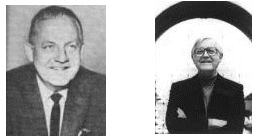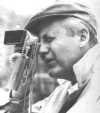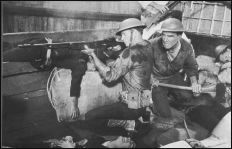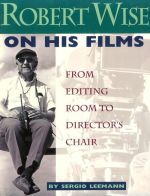
In scope, this film is indeed comparable to either "West Side Story" or "The Sound of Music" but the fabric, on locations in Taiwan and Hong Kong, is of action-adventure, the men of the gunboat USS "San Pablo" caught in the transition of China, the change from feudalism to nationalism, the ousting of the treaty gunboats.
Some men enter the field of movie direction because they have a creative urge. Some drift into it from the stage, some from other movie jobs. Robert Wise became a director because he was first a movie fan, sitting in the dime matinees Saturday after Saturday as a child. The creative urge stemmed directly from what was on the screen. He wanted to be a part of it.
Wise was born September 10, 1914, in Winchester, Indiana, the son of a meat packer. As a boy he was always attending the movies, often as much as three times a week. Once he won a season pass to a theatre in a contest and spent more than half his summer vacation watching movies.
He was also interested in journalism but his father's business suffered in the depression and he was unable to continue his studies. His brother, David, then an accountant with RKO Studios, managed to get him a job in that studio's cutting department as a messenger.
Wise was fascinated by the way movies were cut and patched together and was often permitted to try his hand. At the end of nine months, he was made an assistant cutter. Gradually, Wise was given important editing assignments, one of which was with Orson Welles on the famous "Citizen Kane." His work on that led to Welles' second film, "The Magnificent Ambersons," which was interrupted when Welles was asked by the U.S. Government to do a film in South America as part of the Good Neighbor policy. In order to complete "Ambersons," Welles let Wise direct several scenes. Wise then began bombarding the studio executives with requests to direct. In 1943 he was editing "The Curse of the Cat People" when the director was removed because he was behind schedule and Wise was given the job. The picture became a great hit and Wise was firmly established as a director.
For the next few years, Wise worked on routine "B" films but he brought to them something more than routine treatment. In 1947 he and producer Theron Warth were preparing "Blood on the Moon." They prepared it so well that the budget became greater than that normally assigned to a Western. Studio production chief, Dore Schary, withstood pressure to have a better-known director do the film and when "Blood on the Moon" became a critical and financial success, Wise was established as a top-flight director.
His films since then have included many of the most artistic Hollywood productions, pictures like "The Set-up," "The Day The Earth Stood Still." "The Desert Rats," "Executive Suite," "Tribute to a Bad Man," "Somebody Up There Likes Me," "Run Silent, Run Deep," and the highly controversial "I Want To Live."
In 1959, Wise was approached by the Mirisch Co. and asked to produce and direct "West Side Story," a highly successful Broadway musical. He agreed on the condition that Jerome Robbins, who had directed the Broadway production, work with him. To Hollywood's surprise, the co-direction plan worked -- and "West Side Story" won ten Academy Awards, including two to Wise for production and direction.
Wise followed the musical with "Two for the Seesaw" and "The Haunting" and was preparing "The Sand Pebbles" when 20th Century-Fox asked him to take over production and direction on "The Sound of Music." Knowing that "The Sand Pebbles" could not get underway for almost a year, Wise accepted the musical as a co-production with his independent company, Argyle Enterprises.
While on "The Sand Pebbles" location in Hong Kong in Spring 1966, at sea
aboard the gunboat USS "San Pablo," Wise was notified that he had won the 1965
Academy Award as "Best Director" for "The Sound of Music" and that the film
itself, probably the all-time box office champion, had won as "Best Picture." It
was also awarded Oscars for best sound, best editing and best scoring. The next
musical project for Wise is "Star!" starring Julie Andrews.
Source: The Original Motion Picture Soundtrack album (LP) "The
Sand Pebbles" 1966 Twentieth Century Fox Records
Robert Wise Links:
Robert Wise on The Sand Pebbles - excerpt from 1998 Motion
Picture Editors Guild interview (2:32) (.wma) (.rm) (.ogg)
UC Berkley: "Conversation with Robert Wise"
TV-NOW Robert Wise film schedule
Robert Wise information on Internet Movie DataBase (IMDB)
Robert Wise - My Hero
Robert Wise - Answers.com
Robert Wise - A Remembrance By Rick Mitchell
Robert Wise - A Journal of the Making of A Storm in Summer

On McQueen and The Sand Pebbles
TPV: He is also considered a consummate actor in terms of using props.
"The Sand Pebbles has always been one of my favorite films, I suppose because its the most difficult film -- from a physical and logistical standpoint -- that I've ever made. I suppose having suffered through months and months and months of shooting on it, and the weather problems and everything else that went into it, makes a more memorable experience than the others."
"If I had it to do over I suppose I would have simplified the film some. The last I saw it I felt that maybe it would have been better off without the multiple story. Maybe we split our interests too much with the Frenchy/Maily story and would have been better off sticking with Steve (McQueen), Po-Han, the missionaries and the girl and simplifying the story." Source: Amoruso, Marino and Gallagher, John. "Robert Wise: Part One 'The RKO Years." Grand Illusions (Winter 1977)
RW: Yes, he loved props. I'm sure one of the reasons he wanted to do The Sand Pebbles was that he loved motors and engines, and the story is about a man and this big engine. And also it gave him the opportunity to handle those guns. Put a rifle and cartridge belt in his hands and, man, he was in heaven. He loved that. And he did it very well. I would ask him about something and he'd say, "No, you can't do that." He knew his guns.


"When I started planning the film, my first choice for Holman was Paul
Newman. I had a list of five or six names and at the bottom was Steve
McQueen, who I thought would be awfully good in it. I went after Paul,
but he felt it was not for him somehow. When I mentioned Steve to the
front-office people, they told me he was not big enough to carry such an
expensive film. Then I got involved in The Sound of Music. By the time I
got back on The Sand Pebbles in the latter part of 1964, Steve had had
The Great Escape come out, which was a very popular film, and also Love
with the Proper Stranger. I went back to the front office, and they told
me that now it would be fine to have him as Holman.
"Of all the stars whom I worked with, I think Steve knew better what
worked for him on the screen than any other. He had such a sense of what
he could register, and that helped a lot in terms of shaping the
character and the script.
"Steve could be a little moody--up some days, down a little on others.
He always seemed to work a little bit on the end of his fingertips in the
sense of his feelings about things, but he was fine. I only had one
incident with him. I was on the boat one morning lining up a shot with
the cameraman when Steve, who wasn't in this particular shot, came to
talk about some wardrobe matter. I told him,'I'm really involved in the
shot right now. That wardrobe is not going to be used for several days,
so let`s talk about it later,' He went away and came back a couple of
hours later, when I was really in a tense position on another shot. He
said, 'Bob, that wardrobe...' I said, 'For Christ's sake, Steve! Can't
you see I'm tied up in the shot? Let's talk about it at the end of the
day.' Well, his feelings were so hurt that he didn`t speak to me for
three days. When I was directing the actor in a scene, he was fine, but
he wouldn't say anything off the scene. We used to run our rushes every
Sunday morning in the Army post theater in Taipei. That Sunday Steve came
to see them and was thrilled. Everything was fine from then on and he
started speaking to me again.


"It's very difficult working with boats in water. Every time we had to
make another take, it took a long time to swing her around and get her
back in the right position. We had a lot of weather problems in Taiwan.
We would often go out with four, five different calls to shoot different
scenes, depending on the conditions. If the tide was out, we had to try
to shoot things on the deck where you wouldn't see the water. If it was
a good day and the wind was blowing from the bow, I had to shoot a
certain set of scenes because the smoke would have to match. If the wind
was coming from the other way, I'd shoot another set of scenes. I'd have
another call if the wind wasn't a factor. I'd have still another one if
it was overcast; then I'd be doing a winter scene instead of a summer
scene. If the weather was impossible and it rained, as it often did,
we'd go inside a small studio in Taipei where we built some cover sets.
We went on so long having trouble with the weather that we were running
out of cover sets. We had already built the crews quarters on the stage
in Hollywood but we got so scared of running out of work that the
studio dismantled that set, flew it over to Taipei, and we eventually
did all the scenes in the crew's quarters there.
"We were on the shooting schedule for eight and a half months, by far
the longest I've ever been on. A great part of it was caused by the
irrational weather. It was so frustrating sometimes. When you go out
on a day to shoot, it just kills you as a director not to get at least
some kind of simple shot, even if it's just an insert. I went out there
one day; it was a gray, moody day. There wasn't anything I could shoot.
I wanted to get a shot of the stern of the boat with the American flag
hanging against this dark, foreboding sky. That was the only thing I
could think of shooting until the weather straightened out. We got the
shot all lined up. The wind was blowing and we couldn't hold the San
Pablo. We had a tugboat on one side trying to hold her. She was swinging
back and forth, left and right, ruining everything. Just as we were
about to turn the cameras on it, a puff of wind would come, or a cable
would break, and she would swing. After two hours, I said, 'That's it!
I've had it! Wrap everything up get my shoreboat.' I just couldn`t take
it anymore. That was the only time I ever walked off a set. It was the
most difficult location I ever tackled.
"I've often wondered if maybe I tried to tell too many stories in The
Sand Pebbles. It was a multiple-story film--the story of the ship and
the Captain. The story of Holman, the story of Frenchy and Maily, the
story of the mission and the missionaries. I've wondered if, in terms of
interest and length, I should almost have cut out the Frenchy/Maily
story. I would have saved time, but I liked the story and thought that
Dick Attenborough and Marayat Andriane were very touching. Also, I
wanted to try to do the book and that was a very important part of it.
You look back on films sometimes and if they have not been as all-out
successful as you anticipated you try to find reasons why maybe it
didn't come off for audiences as well as you would have liked."
Excerpt:
Robert Wise on His Films
Sergio Leeman
Silman-James Press - 1995